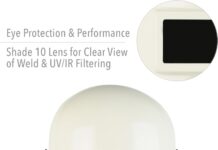Have you ever wondered how long it takes for your eyes to be affected by the intense light of welding? In this article, we explore the fascinating topic of arc eye and shed light on the duration of exposure required for this condition to occur. So, join us as we uncover the secrets behind this commonly known hazard in the welding world. Get ready to learn more about the risks and precautions associated with the mesmerizing yet dangerous glow of welding.
This image is property of images.unsplash.com.
The Basics of Welding
What is welding?
Welding is a skilled process of joining or bonding metal pieces together. It involves the use of heat to melt the edges or surfaces of the metal pieces, allowing them to fuse and form a strong bond. Welding is widely used in various industries such as construction, automotive manufacturing, and aerospace.
Types of welding
There are several different types of welding techniques, each suited for specific applications. Some common types of welding include:
-
Arc welding: This is the most widely used welding technique, which utilizes an electric arc to create the heat necessary for melting the metal. It can be further divided into subcategories such as shielded metal arc welding (SMAW) and gas metal arc welding (GMAW).
-
TIG welding: Also known as tungsten inert gas welding, it uses a non-consumable tungsten electrode to produce the weld. TIG welding is often used for precision work and high-quality welds.
-
MIG welding: This type of welding, also called metal inert gas welding, utilizes a consumable wire electrode and a shielding gas to protect the weld from atmospheric contamination.
-
Resistance welding: It involves passing a high electric current through the metal pieces to be welded, effectively heating and melting the metal at the point of contact.
These are just a few examples of the many types of welding techniques available, each with its own unique advantages and applications.
What is arc eye?
Arc eye, also known as arc flash or ultraviolet keratitis, is a painful eye condition that occurs as a result of exposure to intense ultraviolet (UV) radiation produced during welding. When the eyes are directly exposed to the intense UV rays emitted during welding, it can cause damage to the cornea, conjunctiva, and even the retina. Arc eye is similar to a sunburn on the eye and can cause a range of symptoms, including redness, swelling, sensitivity to light, and a gritty feeling in the eyes.
Understanding Arc Eye
What is arc eye?
Arc eye, as mentioned before, refers to the condition resulting from exposure to intense UV radiation during welding. The UV rays emitted during welding are essentially a concentrated form of sunlight, which can cause severe damage to the eyes if proper protection is not used.
Causes of arc eye
The primary cause of arc eye is exposure to the intense UV radiation emitted during welding. Without proper eye protection, the UV rays can penetrate the eyes’ delicate tissues, leading to inflammation, burns, and damage to the surface of the eye.
Symptoms of arc eye
The symptoms of arc eye can vary in severity but often include:
- Redness and bloodshot appearance of the eyes
- Pain and discomfort
- Grittiness or feeling like there is something in the eye
- Sensitivity to light
- Excessive tearing
- Blurred vision
It is important to note that symptoms may not appear immediately, and there can be a delay of several hours before they become noticeable.
Duration of Exposure
Duration of exposure and arc eye
The duration of exposure to UV radiation during welding plays a significant role in the development of arc eye. The longer the exposure, the greater the likelihood of experiencing the condition. However, it is important to understand that even short-term exposure to intense UV radiation can cause arc eye symptoms to occur.
Threshold limit value (TLV)
The threshold limit value (TLV) is the maximum level of exposure to a hazardous substance, such as UV radiation, that a worker can be exposed to without experiencing adverse effects. In the case of UV radiation, there is no specific TLV established. Therefore, it is crucial to take appropriate measures to minimize exposure and protect the eyes.
Factors affecting risk of arc eye
Several factors can influence the risk of developing arc eye, including:
-
Distance: The closer the eyes are to the welding source, the higher the intensity of UV radiation exposure.
-
Intensity: Higher welding currents and longer welding durations lead to increased UV radiation intensity.
-
Reflective surfaces: Welding near reflective surfaces, such as metal sheets or mirrors, can amplify the intensity of UV radiation.
-
Eye protection: The use of appropriate eye protection significantly reduces the risk of arc eye.
Protective Measures
Importance of protective measures
Protective measures are vital to prevent arc eye and reduce the risk of eye-related injuries during welding. Since UV radiation emitted during welding poses a significant hazard, it is crucial to implement effective safety measures to safeguard the eyes.
Types of eye protection
Several types of eye protection are available to shield the eyes from UV radiation, including:
-
Welding helmets: These specially designed helmets provide full-face protection against UV radiation, sparks, and debris. They have a built-in filter lens, which automatically darkens when the welding arc is struck and clears when the arc stops.
-
Welding goggles: Similar to welding helmets, welding goggles provide eye protection but are smaller in size. They are worn in combination with a protective face shield or welding cap for comprehensive protection.
-
Welding face shields: These transparent shields are designed to cover the entire face, protecting the eyes, face, and neck from UV radiation and welding sparks.
Ensuring proper eye protection
To ensure proper eye protection while welding, it is essential to:
-
Select the appropriate eye protection based on the type of welding being performed and the intensity of UV radiation.
-
Regularly inspect eye protection devices for any damage or wear and replace them as needed.
-
Make sure the eye protection fits properly and does not obstruct vision or comfort.
-
Follow manufacturer’s instructions regarding maintenance and care of eye protection devices.
This image is property of images.unsplash.com.
Industry Standards and Guidelines
OSHA regulations on eye protection
The Occupational Safety and Health Administration (OSHA) has established regulations and guidelines to protect workers’ eyes during welding operations. OSHA mandates that employers must provide suitable eye protection to employees engaged in welding. The specific requirements may vary depending on the industry and type of welding being performed.
AWS guidelines for welding safety
The American Welding Society (AWS) provides comprehensive guidelines and recommendations for safe welding practices. These guidelines cover various aspects of welding safety, including eye protection, and are widely recognized and followed in the welding industry.
International safety standards
In addition to OSHA and AWS guidelines, several international safety standards address eye protection during welding. These standards, such as those from the International Organization for Standardization (ISO), provide a global framework for ensuring safe welding practices and protecting workers’ eyes from hazards like arc eye.
Preventing Arc Eye
Preventing arc eye through awareness
Raising awareness about the risks and consequences of arc eye is crucial for preventing its occurrence. By educating welders and other workers about the importance of eye protection and the potential hazards of UV radiation, the chances of arc eye can be significantly reduced.
Safe welding practices to reduce risk
In addition to using appropriate eye protection, following safe welding practices can help reduce the risk of arc eye. Some essential safe welding practices include:
-
Maintaining a safe distance from the welding arc to minimize UV radiation exposure.
-
Using proper ventilation to reduce the concentration of welding fumes, which can also cause eye irritation.
-
Ensuring proper grounding and electrical safety to prevent electrical shock hazards.
Training and education for welders
Providing comprehensive training and education to welders is essential for their safety and the prevention of arc eye. Welders should receive thorough training on the proper use of eye protection, safe welding techniques, and recognizing and responding to arc eye symptoms. Ongoing education should be emphasized to keep welders up to date with the latest safety practices and guidelines.
This image is property of images.unsplash.com.
Treating Arc Eye
Recognizing arc eye symptoms
Recognizing the symptoms of arc eye is crucial for timely treatment. If you or someone you know has been exposed to welding UV radiation and experiences symptoms such as redness, pain, or sensitivity to light, it is essential to seek immediate medical attention.
Home remedies for arc eye
While seeking medical treatment is always recommended for arc eye, there are a few home remedies that may provide temporary relief:
-
Applying a cold compress or cool, moist cloth to the affected eye can help reduce swelling and soothe discomfort.
-
Over-the-counter artificial tears or lubricating eye drops can help alleviate dryness and irritation.
-
Taking over-the-counter pain relievers, such as ibuprofen or acetaminophen, can help manage pain until medical treatment is obtained.
Seeking medical treatment
Medical treatment should be sought promptly for arc eye. A healthcare professional will be able to assess the severity of the condition and prescribe appropriate medications, such as antibiotic eye drops, to prevent infection. They may also provide further guidance on managing symptoms and protecting the eyes during the healing process.
Long-term Effects
Long-term effects of arc eye
When left untreated or inadequately treated, arc eye can lead to long-term complications and damage to the eyes. Prolonged or recurrent exposure to UV radiation can increase the risk of developing chronic eye conditions and vision problems.
Chronic conditions related to arc eye
Some chronic conditions that can arise from repeated exposure to welding UV radiation include:
-
Photokeratitis: This is a condition similar to arc eye but occurs from exposure to intense sunlight or other sources of UV radiation. It can cause severe pain, temporary vision loss, and long-term damage to the cornea.
-
Cataracts: Prolonged exposure to UV radiation without proper eye protection can increase the risk of developing cataracts, a clouding of the eye’s natural lens that can impair vision.
-
Macular degeneration: UV radiation exposure has been linked to an increased risk of age-related macular degeneration, a leading cause of vision loss in older adults.
Preventing long-term damage
To prevent long-term damage from arc eye and UV radiation exposure, it is crucial to take preventive measures such as:
-
Always wearing appropriate eye protection during welding operations.
-
Avoiding unnecessary exposure to UV radiation from other sources, such as sunlight or tanning beds.
-
Seeking prompt medical treatment for any symptoms of arc eye to prevent complications.
Risk Factors and Vulnerability
Factors that increase vulnerability
Certain factors can increase an individual’s vulnerability to arc eye. These include:
-
Insufficient eye protection: Failing to use proper eye protection or using inadequate eye protection significantly increases the risk of arc eye.
-
Inadequate training: Lack of training on proper welding techniques and the importance of eye protection can make an individual more vulnerable to arc eye.
-
Heavy welding workload: Individuals who engage in frequent or prolonged welding work without sufficient breaks and protection are at a higher risk.
Pre-existing eye conditions
Individuals with pre-existing eye conditions, such as dry eye syndrome or corneal abrasions, may be more susceptible to arc eye. These underlying conditions can make the eyes more sensitive to UV radiation and increase the severity of arc eye symptoms.
Age and cumulative exposure
Age plays a role in the susceptibility to arc eye and its long-term effects. Older individuals may have accumulated more cumulative exposure to UV radiation throughout their years of welding, which can increase the risk of developing chronic eye conditions.
Other Hazards of Welding
Additional hazards of welding
While arc eye is a significant hazard associated with welding, there are other risks that welders should be aware of, including:
-
Inhalation exposure: Welding fumes contain harmful metals and gases, such as zinc, cadmium, and carbon monoxide, which can cause respiratory issues.
-
Skin burns and injuries: Contact with hot metal, sparks, or welding slag can cause burns or injuries to the skin, necessitating proper protective clothing and safe work practices.
It is important for welders to be aware of these hazards and take appropriate precautions to protect themselves from potential injuries or health risks.
In conclusion, understanding the basics of welding and the hazards associated with it is essential for every welder’s safety. Arc eye, caused by exposure to intense UV radiation during welding, can lead to painful symptoms and long-term eye damage if not properly prevented or treated. By implementing protective measures, following safety guidelines, and raising awareness about the risks, welders can significantly reduce the chances of arc eye and other welding-related hazards. Remember, the health of our eyes is invaluable, and prioritizing safety is paramount in the welding industry.










































